Steelix — S&V Paradox Rift #208

Steelix — S&V Paradox Rift #208
Illustrated by: nisimono
More Posts from Violetdawn001 and Others
This is so true and funny. 🤣


Attack and Dethrone (ft. Akari, Arceus, Volo and Emmet)
If you’re gonna blame spacetime rifts for Ingo, blame Volo not Arceus
(Personally I think Ingo got Ultra Wormhole’d. And yes Volo thinks Emmet is Ingo with a clean coat)
What that person said! Best TV show of all time!
If you’re looking for a sci-fi show with….
Realistic takes on technology


Political intrigue and high drama

Complex, strong, and likable female characters





Fun and distinct alien cultures


Infuriating, scary, and delightful villains

Found family and beautiful friendships

Respectful portrayal of religion in a scientifically oriented show

Characters that grow, change, learn, and progress

Strong male leads who portray wise and intelligent leaders
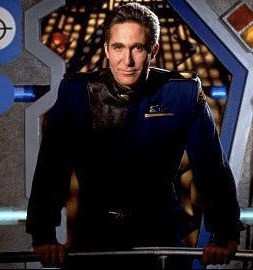

Fantastically complex, fun, and interesting side characters

The ability to balance each character's unique style of humor with seriousness and sincerity




One of the greatest romances of the century

The profoundness of truth






and much more, then Babylon 5 is the show for you

![[ID: Hollow Knight And Ghost Asleep On The Floor. /End ID]](https://64.media.tumblr.com/839a96e576a95819f8461de0435d2e64/8305935c5ea4d631-2a/s500x750/18a8ea67595268afc4899415c1e92515217f367a.png)
[ID: Hollow Knight and Ghost asleep on the floor. /End ID]
Hollow Knight is the silliest looking animal I have ever seen I love them so much
Horse,,, .
This is so beautiful!!!! This amazing lighting!!!!

My piece for @hkhallowzine , a free Hollow Knight zine! It was a honour to work with everyone<3
I love the clone wars trio bc I see them all as different commentaries on the Jedi of the time.
Obi Wan is what the Jedi were.
Anakin is what the Jedi preached against.
Ahsoka is what the Jedi should aspire to be.
Obi Wan had the best of intentions: he wanted to save Anakin, to save Satine, to save Ahsoka. But in the end he failed due to Sith scheming. He was set up to fail, wether it be his dead master or the intergalactic war he was forced to fight in. And in the end Anakin did fall from the light, Satine was killed in Maul's quest for revenge, and Ahsoka walked away. He was a well-intentioned man with a good heart who was ultimately set up to fail by the Sith.
Anakin too wanted safety for his loved ones, but he took it to far. Instead of prioritizing those people, their wants and needs, he prioritized the way they made him felt. Instead of selfless love, he loved selfishly, which is exactlaly what the Jedi are against. They're not against love, they're against attachment. Anakin couldn't let go of Ahsoka: it corroded his faith in the Jedi, sowed seeds of resentment. He couldn't accept that Padme or Obi Wan didn't agree with his vision, because if they don't make him feel good, then they no longer love him. Anakin was a kind boy twisted by the Sith and his misguided attachment to others.
Ahsoka falls into a similar category as Obi Wan, except for one detial. She walked away. She recognized that the Jedi were unintentionally loosing themselves in war. And even through she was a spectacular warrior, a talented commander, she recognized that it wasn't supposed to be her job. She was able to let go of her attachment to Anakin and the 501st. She was a product of her masters and friends, of Obi Wan, Anakin, Padme, and all the others who influenced her growth. And even in the end, when her world fell, she still acted with compassion and understanding, which is exactly what a Jedi should be. Despite her discomfort with the twisted meaning of the title, Ahsoka embodied the fundamental traits of a Jedi. Not flawless, but an empathetic peacekeeper capable of embracing love and rejecting attachment.
Idk if I'm articulating it right, but the general idea is there.
whats up?? would you mind giving prompts for “movement”? take for example: “She walks over to the boy”. Instead of saying “She walks”, i would like something more creative?
Synonyms for "Walk"
stroll
saunter
amble
trudge
plod
march
stride
wander
ramble
advance
make one's way
traipse
prowl
skip
Synonyms for "run"
dart
sprint
rush
dash
hurry
scurry
scuttle
charge
gallop
bound
fly
scamper
sprint
race
jog
trot
I hope this helps! Let me know if I got what you wanted :)
Excuse me while I reblog this for future reference...
Words for Skin Tone | How to Describe Skin Color
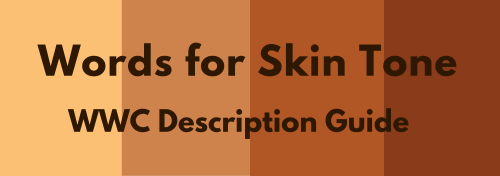
We discussed the issues describing People of Color by means of food in Part I of this guide, which brought rise to even more questions, mostly along the lines of “So, if food’s not an option, what can I use?” Well, I was just getting to that!
This final portion focuses on describing skin tone, with photo and passage examples provided throughout. I hope to cover everything from the use of straight-forward description to the more creatively-inclined, keeping in mind the questions we’ve received on this topic.
Standard Description
Basic Colors

Pictured above: Black, Brown, Beige, White, Pink.
“She had brown skin.”
This is a perfectly fine description that, while not providing the most detail, works well and will never become cliché.
Describing characters’ skin as simply brown or beige works on its own, though it’s not particularly telling just from the range in brown alone.
Complex Colors
These are more rarely used words that actually “mean” their color. Some of these have multiple meanings, so you’ll want to look into those to determine what other associations a word might have.

Pictured above: Umber, Sepia, Ochre, Russet, Terra-cotta, Gold, Tawny, Taupe, Khaki, Fawn.
Complex colors work well alone, though often pair well with a basic color in regards to narrowing down shade/tone.
For example: Golden brown, russet brown, tawny beige…
As some of these are on the “rare” side, sliding in a definition of the word within the sentence itself may help readers who are unfamiliar with the term visualize the color without seeking a dictionary.
“He was tall and slim, his skin a russet, reddish-brown.”
Comparisons to familiar colors or visuals are also helpful:
“His skin was an ochre color, much like the mellow-brown light that bathed the forest.”
Modifiers
Modifiers, often adjectives, make partial changes to a word.The following words are descriptors in reference to skin tone.
Dark - Deep - Rich - Cool
Warm - Medium - Tan
Fair - Light - Pale
Rich Black, Dark brown, Warm beige, Pale pink…
If you’re looking to get more specific than “brown,” modifiers narrow down shade further.
Keep in mind that these modifiers are not exactly colors.
As an already brown-skinned person, I get tan from a lot of sun and resultingly become a darker, deeper brown. I turn a pale, more yellow-brown in the winter.
While best used in combination with a color, I suppose words like “tan” “fair” and “light” do work alone; just note that tan is less likely to be taken for “naturally tan” and much more likely a tanned White person.
Calling someone “dark” as description on its own is offensive to some and also ambiguous. (See: Describing Skin as Dark)
Undertones
Undertones are the colors beneath the skin, seeing as skin isn’t just one even color but has more subdued tones within the dominating palette.
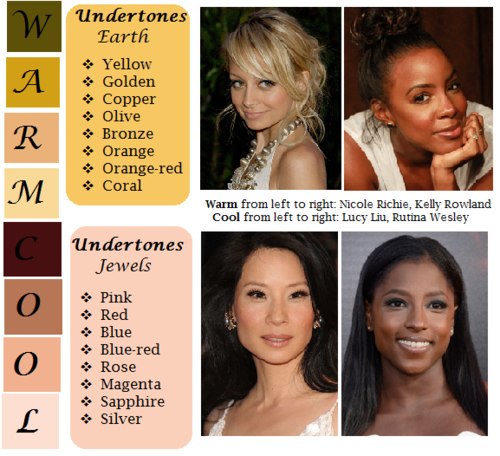
pictured above: warm / earth undertones: yellow, golden, copper, olive, bronze, orange, orange-red, coral | cool / jewel undertones: pink, red, blue, blue-red, rose, magenta, sapphire, silver.
Mentioning the undertones within a character’s skin is an even more precise way to denote skin tone.
As shown, there’s a difference between say, brown skin with warm orange-red undertones (Kelly Rowland) and brown skin with cool, jewel undertones (Rutina Wesley).
“A dazzling smile revealed the bronze glow at her cheeks.”
“He always looked as if he’d ran a mile, a constant tinge of pink under his tawny skin.”
Standard Description Passage
“Farah’s skin, always fawn, had burned and freckled under the summer’s sun. Even at the cusp of autumn, an uneven tan clung to her skin like burrs. So unlike the smooth, red-brown ochre of her mother, which the sun had richened to a blessing.”
-From my story “Where Summer Ends” featured in Strange Little Girls
Here the state of skin also gives insight on character.
Note my use of “fawn” in regards to multiple meaning and association. While fawn is a color, it’s also a small, timid deer, which describes this very traumatized character of mine perfectly.
Though I use standard descriptions of skin tone more in my writing, at the same time I’m no stranger to creative descriptions, and do enjoy the occasional artsy detail of a character.
Creative Description
Whether compared to night-cast rivers or day’s first light…I actually enjoy seeing Characters of Colors dressed in artful detail.
I’ve read loads of descriptions in my day of white characters and their “smooth rose-tinged ivory skin”, while the PoC, if there, are reduced to something from a candy bowl or a Starbucks drink, so to actually read of PoC described in lavish detail can be somewhat of a treat.
Still, be mindful when you get creative with your character descriptions. Too many frills can become purple-prose-like, so do what feels right for your writing when and where. Not every character or scene warrants a creative description, either. Especially if they’re not even a secondary character.
Using a combination of color descriptions from standard to creative is probably a better method than straight creative. But again, do what’s good for your tale.
Natural Settings - Sky

Pictured above: Harvest Moon -Twilight, Fall/Autumn Leaves, Clay, Desert/Sahara, Sunlight - Sunrise - Sunset - Afterglow - Dawn- Day- Daybreak, Field - Prairie - Wheat, Mountain/Cliff, Beach/Sand/Straw/Hay.
Now before you run off to compare your heroine’s skin to the harvest moon or a cliff side, think about the associations to your words.
When I think cliff, I think of jagged, perilous, rough. I hear sand and picture grainy, yet smooth. Calm. mellow.
So consider your character and what you see fit to compare them to.
Also consider whose perspective you’re describing them from. Someone describing a person they revere or admire may have a more pleasant, loftier description than someone who can’t stand the person.
“Her face was like the fire-gold glow of dawn, lifting my gaze, drawing me in.”
“She had a sandy complexion, smooth and tawny.”
Even creative descriptions tend to draw help from your standard words.
Flowers
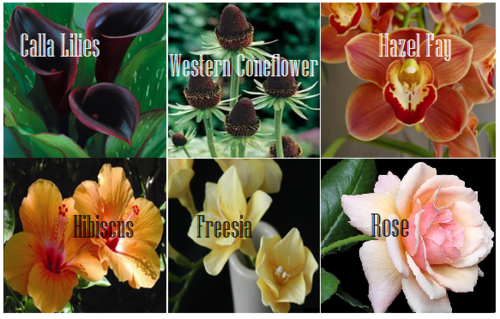
Pictured above: Calla lilies, Western Coneflower, Hazel Fay, Hibiscus, Freesia, Rose
It was a bit difficult to find flowers to my liking that didn’t have a 20 character name or wasn’t called something like “chocolate silk” so these are the finalists.
You’ll definitely want to avoid purple-prose here.
Also be aware of flowers that most might’ve never heard of. Roses are easy, as most know the look and coloring(s) of this plant. But Western coneflowers? Calla lilies? Maybe not so much.
“He entered the cottage in a huff, cheeks a blushing brown like the flowers Nana planted right under my window. Hazel Fay she called them, was it?”
Assorted Plants & Nature

Pictured above: Cattails, Seashell, Driftwood, Pinecone, Acorn, Amber
These ones are kinda odd. Perhaps because I’ve never seen these in comparison to skin tone, With the exception of amber.
At least they’re common enough that most may have an idea what you’re talking about at the mention of “pinecone.“
I suggest reading out your sentences aloud to get a better feel of how it’ll sounds.
"Auburn hair swept past pointed ears, set around a face like an acorn both in shape and shade.”
I pictured some tree-dwelling being or person from a fantasy world in this example, which makes the comparison more appropriate.
I don’t suggest using a comparison just “cuz you can” but actually being thoughtful about what you’re comparing your character to and how it applies to your character and/or setting.
Wood

Pictured above: Mahogany, Walnut, Chestnut, Golden Oak, Ash
Wood can be an iffy description for skin tone. Not only due to several of them having “foody” terminology within their names, but again, associations.
Some people would prefer not to compare/be compared to wood at all, so get opinions, try it aloud, and make sure it’s appropriate to the character if you do use it.
“The old warlock’s skin was a deep shade of mahogany, his stare serious and firm as it held mine.”
Metals

Pictured above: Platinum, Copper, Brass, Gold, Bronze
Copper skin, brass-colored skin, golden skin…
I’ve even heard variations of these used before by comparison to an object of the same properties/coloring, such as penny for copper.
These also work well with modifiers.
“The dress of fine white silks popped against the deep bronze of her skin.”
Gemstones - Minerals
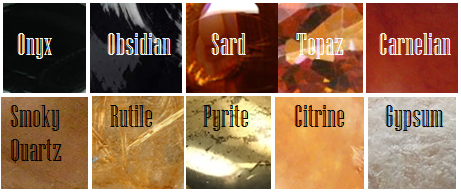
Pictured above: Onyx, Obsidian, Sard, Topaz, Carnelian, Smoky Quartz, Rutile, Pyrite, Citrine, Gypsum
These are trickier to use. As with some complex colors, the writer will have to get us to understand what most of these look like.
If you use these, or any more rare description, consider if it actually “fits” the book or scene.
Even if you’re able to get us to picture what “rutile” looks like, why are you using this description as opposed to something else? Have that answer for yourself.
“His skin reminded her of the topaz ring her father wore at his finger, a gleaming stone of brown, mellow facades.”
Physical Description
Physical character description can be more than skin tone.
Show us hair, eyes, noses, mouth, hands…body posture, body shape, skin texture… though not necessarily all of those nor at once.
Describing features also helps indicate race, especially if your character has some traits common within the race they are, such as afro hair to a Black character.
How comprehensive you decide to get is up to you. I wouldn’t overdo it and get specific to every mole and birthmark. Noting defining characteristics is good, though, like slightly spaced front teeth, curls that stay flopping in their face, hands freckled with sunspots…
General Tips
Indicate Race Early: I suggest indicators of race be made at the earliest convenience within the writing, with more hints threaded throughout here and there.
Get Creative On Your Own: Obviously, I couldn’t cover every proper color or comparison in which has been “approved” to use for your characters’ skin color, so it’s up to you to use discretion when seeking other ways and shades to describe skin tone.
Skin Color May Not Be Enough: Describing skin tone isn’t always enough to indicate someone’s ethnicity. As timeless cases with readers equating brown to “dark white” or something, more indicators of race may be needed.
Describe White characters and PoC Alike: You should describe the race and/or skin tone of your white characters just as you do your Characters of Color. If you don’t, you risk implying that White is the default human being and PoC are the “Other”).
PSA: Don’t use “Colored.” Based on some asks we’ve received using this word, I’d like to say that unless you or your character is a racist grandmama from the 1960s, do not call People of Color “colored” please.
Not Sure Where to Start? You really can’t go wrong using basic colors for your skin descriptions. It’s actually what many people prefer and works best for most writing. Personally, I tend to describe my characters using a combo of basic colors + modifiers, with mentions of undertones at times. I do like to veer into more creative descriptions on occasion.
Want some alternatives to “skin” or “skin color”? Try: Appearance, blend, blush, cast, coloring, complexion, flush, glow, hue, overtone, palette, pigmentation, rinse, shade, sheen, spectrum, tinge, tint, tone, undertone, value, wash.
Skin Tone Resources
List of Color Names
The Color Thesaurus
Skin Undertone & Color Matching
Tips and Words on Describing Skin
Photos: Undertones Described (Modifiers included)
Online Thesaurus (try colors, such as “red” & “brown”)
Don’t Call me Pastries: Creative Skin Tones w/ pics I
Writing & Description Guides
WWC Featured Description Posts
WWC Guide: Words to Describe Hair
Writing with Color: Description & Skin Color Tags
7 Offensive Mistakes Well-intentioned Writers Make
I tried to be as comprehensive as possible with this guide, but if you have a question regarding describing skin color that hasn’t been answered within part I or II of this guide, or have more questions after reading this post, feel free to ask!
~ Mod Colette
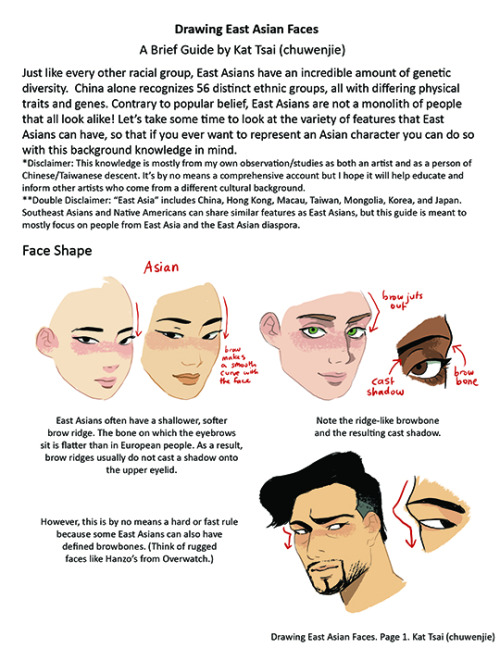
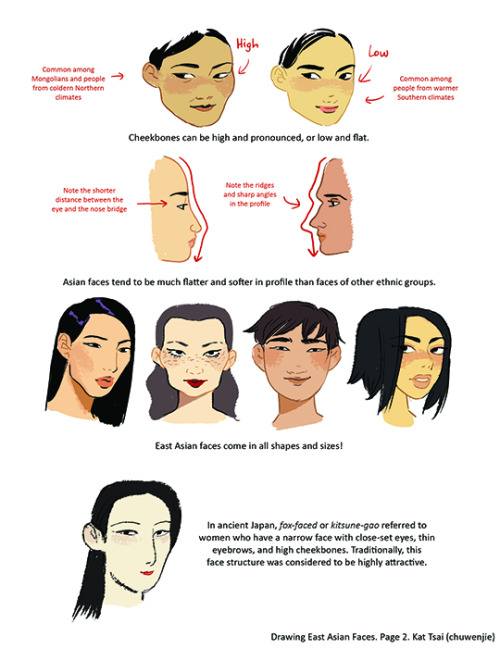

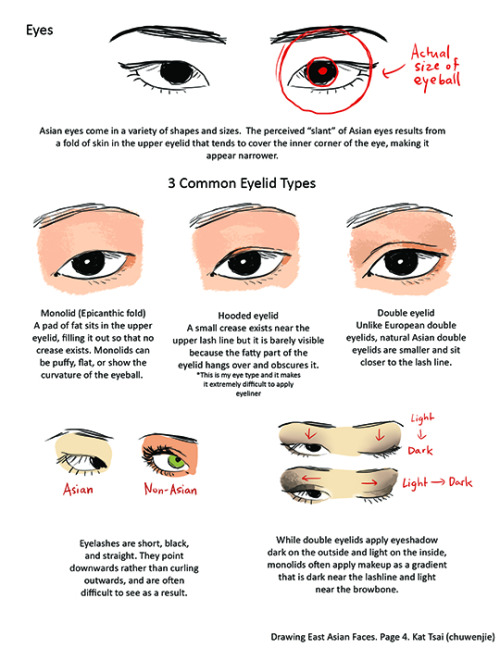

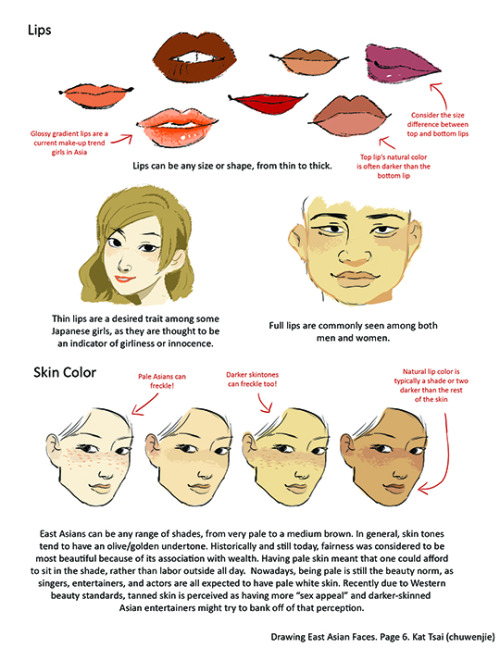
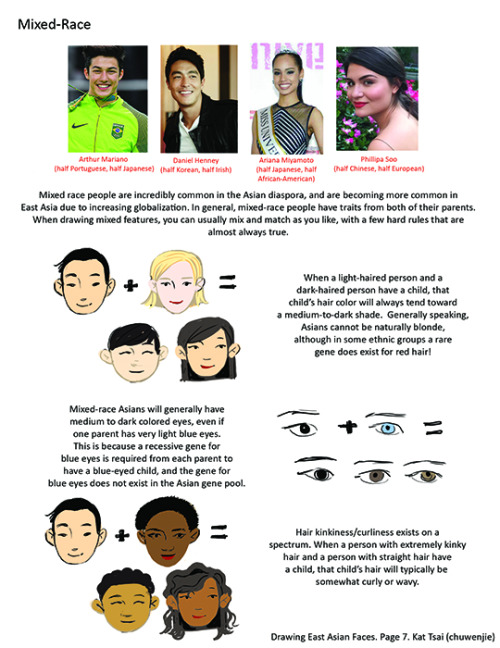
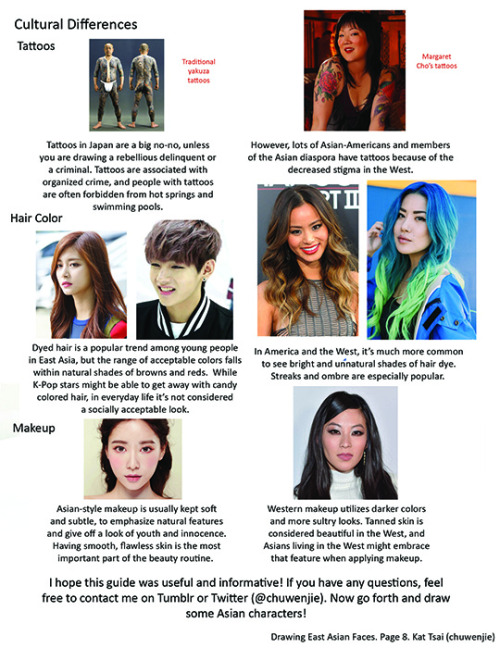
A compilation of stuff I know about drawing Asian faces and Asian culture! I feel like many “How-To-Draw” tutorials often default to European faces and are not really helpful when drawing people of other races. So I thought I’d put this together in case anyone is interested! Feel free to share this guide and shoot me questions if you have any! I’m by no means an expert, I just know a few things from drawing experience and from my own cultural background.
-
 quirkle2 liked this · 4 weeks ago
quirkle2 liked this · 4 weeks ago -
 nimfia liked this · 1 month ago
nimfia liked this · 1 month ago -
 sylvan-sanctum reblogged this · 2 months ago
sylvan-sanctum reblogged this · 2 months ago -
 artificial-ascension reblogged this · 2 months ago
artificial-ascension reblogged this · 2 months ago -
 artificial-ascension liked this · 2 months ago
artificial-ascension liked this · 2 months ago -
 dougzilla7 liked this · 2 months ago
dougzilla7 liked this · 2 months ago -
 thorkdraws liked this · 3 months ago
thorkdraws liked this · 3 months ago -
 super-mega-foxy-awesome-hawt liked this · 3 months ago
super-mega-foxy-awesome-hawt liked this · 3 months ago -
 vodkamademedoit liked this · 3 months ago
vodkamademedoit liked this · 3 months ago -
 myprettaylittlemind reblogged this · 3 months ago
myprettaylittlemind reblogged this · 3 months ago -
 myprettaylittlemind liked this · 3 months ago
myprettaylittlemind liked this · 3 months ago -
 thesparklingpariah liked this · 3 months ago
thesparklingpariah liked this · 3 months ago -
 cultkueen liked this · 3 months ago
cultkueen liked this · 3 months ago -
 meorise reblogged this · 4 months ago
meorise reblogged this · 4 months ago -
 blueeyed-cheshire liked this · 4 months ago
blueeyed-cheshire liked this · 4 months ago -
 thatwhatthing liked this · 4 months ago
thatwhatthing liked this · 4 months ago -
 ephraim reblogged this · 4 months ago
ephraim reblogged this · 4 months ago -
 alipal1595 liked this · 4 months ago
alipal1595 liked this · 4 months ago -
 pizzaback reblogged this · 4 months ago
pizzaback reblogged this · 4 months ago -
 we-weavile reblogged this · 4 months ago
we-weavile reblogged this · 4 months ago -
 aealoarcturus reblogged this · 4 months ago
aealoarcturus reblogged this · 4 months ago -
 robrobot reblogged this · 5 months ago
robrobot reblogged this · 5 months ago -
 soapeater1917 liked this · 5 months ago
soapeater1917 liked this · 5 months ago -
 foolishfoolsgold liked this · 5 months ago
foolishfoolsgold liked this · 5 months ago -
 theicecreamremedy reblogged this · 5 months ago
theicecreamremedy reblogged this · 5 months ago -
 dreamieclouds liked this · 5 months ago
dreamieclouds liked this · 5 months ago -
 alola03 reblogged this · 5 months ago
alola03 reblogged this · 5 months ago -
 r-fenghuang liked this · 5 months ago
r-fenghuang liked this · 5 months ago -
 lireb-librarian liked this · 5 months ago
lireb-librarian liked this · 5 months ago -
 fae-sama-boi reblogged this · 5 months ago
fae-sama-boi reblogged this · 5 months ago -
 literallyrik reblogged this · 5 months ago
literallyrik reblogged this · 5 months ago -
 a-little-ray-of-fantasy reblogged this · 5 months ago
a-little-ray-of-fantasy reblogged this · 5 months ago -
 feathersofdream liked this · 5 months ago
feathersofdream liked this · 5 months ago -
 tj3star liked this · 5 months ago
tj3star liked this · 5 months ago -
 playhouse-disney liked this · 5 months ago
playhouse-disney liked this · 5 months ago -
 lesbianpikachu reblogged this · 5 months ago
lesbianpikachu reblogged this · 5 months ago -
 pendinv liked this · 5 months ago
pendinv liked this · 5 months ago -
 daychiie liked this · 5 months ago
daychiie liked this · 5 months ago -
 kintsugi-tigerstripes reblogged this · 5 months ago
kintsugi-tigerstripes reblogged this · 5 months ago -
 monoswampland liked this · 5 months ago
monoswampland liked this · 5 months ago -
 sirilampo reblogged this · 5 months ago
sirilampo reblogged this · 5 months ago -
 eepysalamander reblogged this · 5 months ago
eepysalamander reblogged this · 5 months ago -
 eepysalamander liked this · 5 months ago
eepysalamander liked this · 5 months ago -
 realhumanperson1 liked this · 5 months ago
realhumanperson1 liked this · 5 months ago -
 volknerslegs liked this · 5 months ago
volknerslegs liked this · 5 months ago -
 meetmeinhoenn reblogged this · 5 months ago
meetmeinhoenn reblogged this · 5 months ago -
 teacuprevelry reblogged this · 5 months ago
teacuprevelry reblogged this · 5 months ago -
 darkespeon reblogged this · 5 months ago
darkespeon reblogged this · 5 months ago -
 a-little-ray-of-fantasy liked this · 5 months ago
a-little-ray-of-fantasy liked this · 5 months ago


